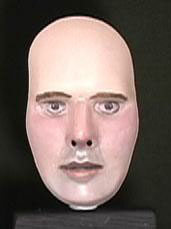Schizophrenics see through hollow-mask illusion
 (New Scientist) Telling the front from the back of a mask can be more difficult than it seems. Thanks to an effect called the hollow-mask illusion, the brain can have trouble deciding if the image is convex or concave. But, it seems, not everyone struggles to correctly determine the mask’s orientation. New research shows that people with schizophrenia are immune to the effect – a finding that means the illusion could provide a diagnostic test for the condition.
(New Scientist) Telling the front from the back of a mask can be more difficult than it seems. Thanks to an effect called the hollow-mask illusion, the brain can have trouble deciding if the image is convex or concave. But, it seems, not everyone struggles to correctly determine the mask’s orientation. New research shows that people with schizophrenia are immune to the effect – a finding that means the illusion could provide a diagnostic test for the condition.
Mystech: This goes a long way towards explaining that one guy at the Halloween party that always wore his mask inside out.
In the study, volunteers were monitored in an fMRI (functional Magnetic Resonance Imaging) scanner as they looked at photos. Some of these were normal pictures of faces, but others had been inverted as in the hollow-mask illusion. All the participants with schizophrenia could distinguish between the two types of photos, whereas control volunteers without the condition were fooled 99 per cent of the time.
People with schizophrenia, which affects about 1 per cent of the population, are already known to be immune to certain visual illusions. Immunity to the hollow-mask illusion, says Danai Dima, of Hannover School of Medicine in Germany, suggests that the “bottom-up” process of collecting incoming visual information from the eyes, and the “top-down” process of interpreting this information is different in people with schizophrenia.
“The term ‘schizophrenia’ was coined almost a century ago to mean the splitting of different mental domains, but the idea has now shifted more towards connectivity between brain areas,” says Dima.
The prevailing theory is that perception comprises three main components: sensory input (bottom-up); the internal production of concepts (top-down); and a control component, which covers interaction between the two first components. “Our study provides further evidence of ‘dysconnectivity’ between these components in the brains of people with schizophrenia.”






